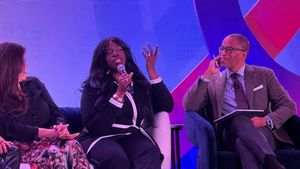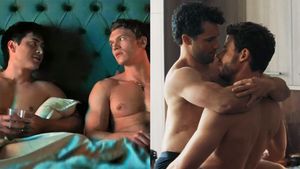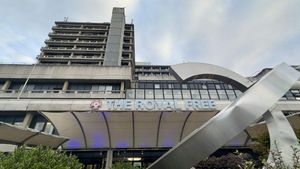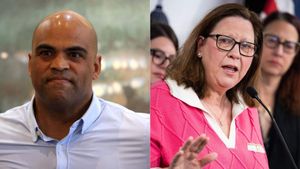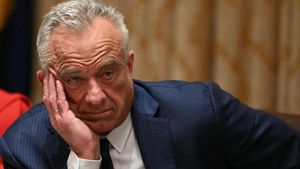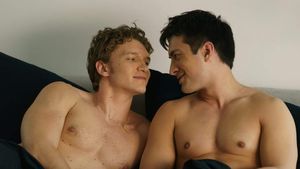Story and Photos by Justin Ocean
“A week-long exploration into the luxe queer side of the Rainbow Nation.”
Day 5, Cape Town
Cape Town is definitely a city of contrasts. Right now, I’m getting the visceral feel for one as the darkened deeds of a late Friday night rail against intense UV rays shimmering off ice-blue waves. Thank god I have my sunglasses.
Glancing around the absolutely gorgeous powdery white, boulder-dotted of Clifton Third, the gayest in a string of five small beaches surrounded by multi-million rand bungalows creeping up a sheer mountain, it’s easy to forget that the riches on display here — mansions that would put Malibu to shame, not to mention oiled-up bodies that barely fit in their speedos — are an anomaly and not the norm. (Well, except for the muscles; Cape Town is rife in hot men!)
Just kilometers away lie townships that would rival any cobbled-together favela in slum-rich Rio, which measures just lower (i.e. less drastic) on the Gini Index of income inequality according to the CIA World Factbook. In a town that’s practically made for Sunday drives, with hills and valleys and panoramic views around every corner, the quaint seaside suburbs of Hout Bay, Fish Hoek and Muizenberg and the wooded, vineyard-laden Constantia are every bit as opulent as the Cape Flats strip malls and shantytowns are bleak — all within a half hour of downtown.
As the World Cup soccer stadium rises, scheduled rolling power
blackouts continue to plague the country. Crime isn’t as pervasive as
popular conception (I never felt unsafe walking alone in the more toney
suburbs by day and with friends at night) but walled houses still have
panic buttons and cars have alarms you have to constantly disable as
you drive. It’s First World paired with Third, in a heady, simmering
mix.
But that duality is what makes South Africa an amazingly
interesting destination to visit. It’s fresh and palpitating with an
energy bent on reinvention. Consider the less-than-15-year distance
from racist apartheid
to some of the most socially advanced legal protections -- especially
towards LGBT community -- in the world, all without a civil war.
You’d be hard pressed not to meet a local who didn’t live through
this “bloodless” democratic revolution and doesn’t have their own
strong opinions about the state of the country now. The most
fascinating and impressive part about traveling South Africa is talking
to everyone and peeling away the layers of first impressions for a
richer understanding of its multifaceted, supremely layered social
system.
If you’re inclined towards more official versions, the District Six Museum (a vibrant, formerly mixed jazz-influenced area that was re-districted as “white only” and razed in the late ’60s) and Robben Island (where Nelson Mandela was imprisoned for 27 years) offer up fascinating accounts of recent history.
Shopping does as well, in more nuanced ways. Browsing Long Street
and other burbs around town, I’m struck that most products in the
supermarkets are South African brands and there’s not a Starbucks to be
found. Local fashions are durable, stylish and cheap. Foodstuffs are
tasty and plentiful. Contrary to the gleaming Victoria & Alfred Waterfront
mall and entertainment complex (think: Astin Martin showroom, Diesel
Style Lab, Louis Vuitton and Hugo Boss), years of forced self-reliance
have made the country a refreshing throwback to before America’s
economic tendrils were everywhere. Bargain-worthy (and bargain-able)
quality African handicrafts can be found at the outdoor historic Greenmarket Square.
Nightlife is a microcosm unto itself. Considering there’s about 5
million white South Africans (shorthand for moneyed) to 45 million
black/mixed (who bear the brunt of the country’s almost 35%
unemployment rate), you can estimate only about 500,000 of Cape Town’s
5.2 million residents are able to afford the city’s bars and higher-end
restaurants on a regular basis. Which is to say, it’s a small, easily
navigable scene (give it a week and you’ll know “everyone”) so the
burgeoning diversity amidst the homogeneity and hedonism is all the
more impressive.
On the so-called Pink Block in Green Point, the mixed lesbian scene at Beaulah sees boys and girls of all shades sweatin’ to killer electro DJs. Around the corner at Loft
a posher crowd sips cocktails in a modern, positively soaring space,
while everyone seems to end up with their shirts off next door at divey
Bronx.
Nearby at The Friendly Society, videos of patrons scroll on video screens as “no lip synching” black drag queen Odidiva belts Macy Gray. The gay owners of the Metropole Hotel have classed up cocktail hour with M Bar & Lounge’s
mixed crowd, red ostrich skin settes, dark wood walls and urinals that
have you peeing on ice while looking through an aquarium. They’ve even
translated that modern African décor to Hot House, a popular and frisky bathhouse with a vibe that manages to feel luxurious.
Farther afield, where few of the Cape Towners I met admit they tread, Star Gayzer in Parow
suburb is a heart-warming eye opener. Located in a mostly middle class
Cape Coloured community (mixed descendents of the original Malay
slaves), drinks are cheap, there’s a grill out back and everybody seems
to bump on the smokey dance floor. Admittedly a bit cheesy, anybody who
grew up with a small town gay bar will immediately recognize the
inclusive, low-key vibe. And anybody who went to that bar in rural
yee-haw country has to check out the monthly Gat Party
(pronounced like “hot” while hoching loogie). Afrikaaner for butt
(literally “hole”), it’s a kind of hoedown for descendents of Dutch
farmers, the “rednecks” of South Africa. Expect BYOB sauciness in a
gymnasium while old-timers long-arm line dance and twentysomething
twinks pop and lock to more mainstream tracks.
There might be 11 official languages in South Africa, but whatever
the social situation, when it comes to partying everybody moves to
Madonna.
Continue to Day 6, Cape Town to Franschhoek Winelands
Go back to Day 4, Cape Town










































